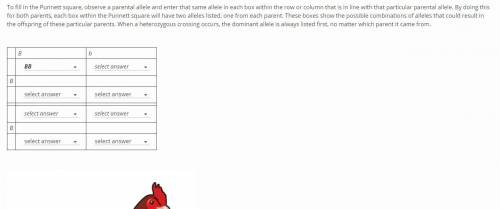
Biology, 04.11.2021 14:00 Animallover100
A diploid organism has two alleles for every gene. These alleles are each copied (during DNA replication) and separated (through meiosis) so that one allele goes into each haploid gamete. The fact that alleles separate from each other to sort individually into gametes is an example of the law of segregation. A single gamete from one individual combines with a single gamete from another individual (during fertilization) to create, once again, one diploid cell with two alleles. The individuals that provide the gametes are known as the parents, and the cell or cells that result from fertilization are known as offspring.
If the genotypes of two parent organisms are known, it is possible to calculate the possible genotypes and phenotypes that will be present in the offspring. A simple way to visually represent this is through the use of a Punnett square. The simplest Punnett squares observe a single gene in the parents and offspring.
The following Punnett square displays the gene for color in chickens. In this example, the allele for brown color (B) is dominant to the allele for white color (b). The genotype of each parent is shown, along with an image portraying the phenotype. Complete the Punnett square to show the possible offspring these two individuals could have.
You can use any letter to represent alleles as long as you always indicate the dominant allele with a capital letter and the recessive allele with a lowercase letter.
This Punnett square shows the possible combinations of two alleles of a single gene. The alleles of the parents are listed on the top and left sides of the square. One allele aligns with each box in the square. Generally, the convention is to list the female organism on the top and the male organism at the left.
To fill in the Punnett square, observe a parental allele and enter that same allele in each box within the row or column that is in line with that particular parental allele. By doing this for both parents, each box within the Punnett square will have two alleles listed, one from each parent. These boxes show the possible combinations of alleles that could result in the offspring of these particular parents. When a heterozygous crossing occurs, the dominant allele is always listed first, no matter which parent it came from.


Answers: 3
Another question on Biology


Biology, 22.06.2019 04:20
Explain the significance of the increased cell specialization of the volvocine line
Answers: 1

Biology, 22.06.2019 16:50
An enzymatic hydrolysis of fructose-1-p, fructose-1-p(aq) + h2o(l) - fructose (aq) + pi (aq) was allowed to proceed to equilibrium at 25°c. the original concentration of fructose-1-p was 0.2 m, but when the system had reached equilibrium, the concentration of fructose-1-p was only 6.52 x 10^-5 m. calculate the equilibrium constant for this reaction and the free energy of hydrolysis of fructose-1-p.
Answers: 1

Biology, 22.06.2019 17:00
Which of the following terms would bb represent in an organism? a.phenotype b.genotype c.genetics
Answers: 2
You know the right answer?
A diploid organism has two alleles for every gene. These alleles are each copied (during DNA replica...
Questions

Mathematics, 08.09.2021 19:30

Spanish, 08.09.2021 19:30




Mathematics, 08.09.2021 19:30

Mathematics, 08.09.2021 19:30


Mathematics, 08.09.2021 19:30


Mathematics, 08.09.2021 19:30

Mathematics, 08.09.2021 19:30


Physics, 08.09.2021 19:30

History, 08.09.2021 19:30

Health, 08.09.2021 19:30


Mathematics, 08.09.2021 19:30




